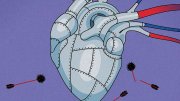In January 2022, a 57-year-old man named David Bennett Sr. made history when he became the first human patient to receive a heart transplanted from a genetically modified pig. The procedure, known as a xenotransplant, has been heralded as the solution for an acute shortage of transplant organs, which results in the deaths of perhaps a dozen Americans every day. Faced with the prospect of certain death from heart disease, Bennett opted for the first-of-its-kind procedure after he had exhausted all options for a human heart transplant. Initially, his transplant operation was celebrated as an unqualified success that would transform the field of medicine. But less than two months later, Bennett was dead.
The apparent cause was porcine cytomegalovirus, a common pig virus that had hitched a ride on the transplanted heart. Although experts don’t think the virus is capable of infecting human cells, if it begins to multiply in the human body, that can trigger a strong immune response, leading to serious health problems or even—as in Bennett’s case—death. If xenotransplants are to deliver on their promise of overcoming organ shortages, physicians need a way to guarantee that the transplants are virus-free.
Harvard researchers may finally have found a path forward. As detailed recently in Nature, a team led by Winthrop professor of genetics George Church and Akos Nyerges, a research fellow in his lab at the Medical School, has developed what is believed to be the world’s first bacterium that is immune to all known viral infections. The scientists genetically modified a non-pathogenic bacterial species, E. coli, which is commonly used in industrial applications such as insulin and biofuel production, but they believe that the technique might one day be applied to make entire mammalian organs immune to viruses, preventing the kinds of infections that led to Bennett’s death.
“This should be applicable to plants, animals, and even human cells,” says Church. “In principle, you could make almost any organ we currently transplant resistant to all viruses using the same strategy. We’re not there yet, but we have a roadmap now that it’s been proven for at least one organism.”
The results unveiled in March have been decades in the making. A 2001 research project led by Church for the U.S. Defense Advanced Research Projects Agency demonstrated that it was possible to create a synthetic E. coli operon, a group of genes that are responsible for regulating protein synthesis in the bacteria. By selectively altering these genes—viruses rely on a cell’s protein synthesis machinery to replicate—he realized it would be possible to create E. coli that are resistant to viruses and to do so in a way that would prevent the potentially dangerous spread of virus-resistant bacteria that could outcompete other bacteria in the wild, including the many beneficial species that live in our gut or are used in a variety of industrial processes.
In 2013, Church and his collaborators created the first E. coli bacteria containing synthetic DNA that made it resistant to some viruses, but a method for making the bacteria resistant to all viruses while also preventing uncontrolled replication remained elusive. The key to the recent breakthrough lies in modifying the function of transfer RNA (tRNA), which Church describes as “probably the most key part of life.”
Transfer RNA is present in all living things and binds to specific triplets of nucleic acids, known as codons, that contain the code for producing a particular protein. They are effectively a bridge between the world of DNA and protein synthesis that makes life possible. But tRNA is also used by viruses to reprogram a host cell’s DNA and turn the cell into a factory producing the raw genetic material the virus needs to replicate. Because the viral tRNA is seeking out specific codons within its hosts, Church and Nyerges knew that it should be possible to disrupt an infection by swapping out the target codon with a synthetic substitute. In that case, the virus would essentially be carrying a key to the cell’s protein factory, only to find that Church and his colleagues had changed all the locks.
“We’re throwing a wrench into a virus’s natural life cycle by removing a very fundamental process for their protein synthesis,” said Nyerges. “It’s incompatible with anything natural.”
To test the viral resistance of their genetically modified bacteria, the researchers collected dozens of samples carrying viruses known to infect E. coli from the Muddy River and other sites around Massachusetts. So far, none of the collected samples have managed to infect their modified bacteria, leading the team to believe that they are the first to achieve total viral resistance in a synthetic organism.
Because virus-resistant bacteria could outcompete other strains, potentially becoming a biohazard (certain strains of E. coli are pathogenic and responsible for nearly a quarter-million illnesses and dozens of deaths each year in the United States), the team engineered the E. coli to be dependent on a lab-made amino acid called bipA that is not found in nature. “In a way, this whole project is about safety,” says Church. “Nobody should make a virus-resistant cell until they’ve bio-contained it first. We made this bacteria dependent upon an amino acid that isn’t available in the wild, and so as soon as it runs out of bipA, it dies.” In effect, this synthetic amino acid acts as a firewall that only allows the bacteria to reproduce in artificial, human-controlled environments. (By feeding the culture bipA, the virus-resistant strain can still be used for industrial applications, such as insulin production.)
Together, these innovations open the door for engineering more virus-resistant bacteria and other cells in the future. Although Nyerges admits much more research must be done before it’s possible to engineer a virus-resistant xenotransplant, he sees no reason the genetic engineering techniques used to engineer virus-resistant E. coli can’t be applied to mammalian organs. “I don’t think it’s going to happen in the next five to ten years, but I think it’s absolutely possible,” he said. “There are people around the globe working to make this happen. We still have a lot to learn, but we’ll get there eventually.”









